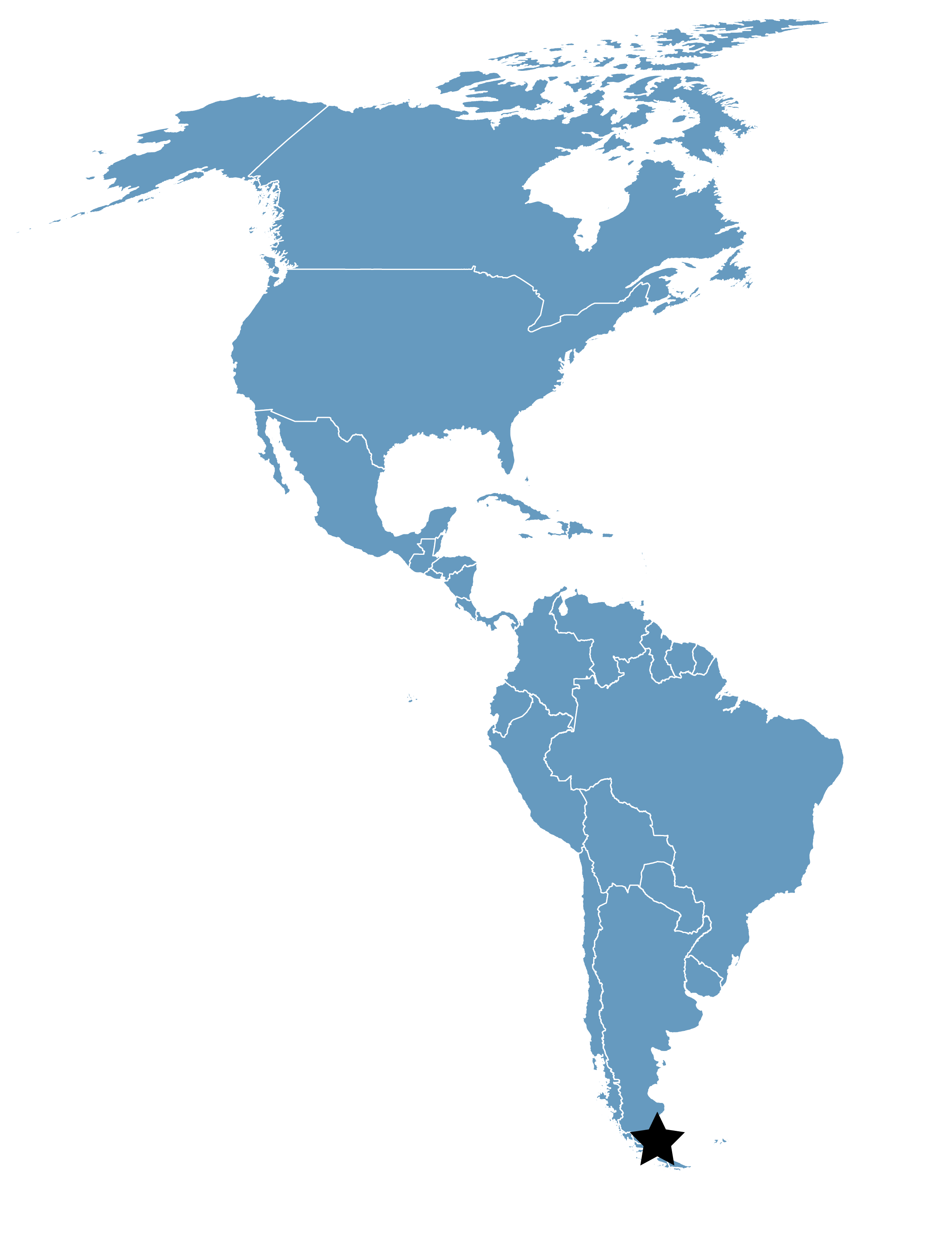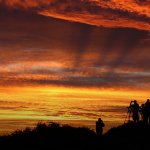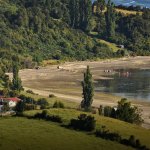Costa Atlántica de Tierra del Fuego
Location
Tierra del Fuego, Argentina
Category
Hemispheric
Basis for Designation
Most important wintering site for 42% of the continental population of Hudsonian Godwits (Limosa haemastica) and 13.7% of the continental population of Red Knots (Caldris cantus rufa).
Size
28,600 hectares (70,672 acres)
Date Designated
December 1992
Site Owner
Department of Protected Areas and Biodiversity of the Provincial Government of Tierra del Fuego
Site Partners
Environment, Sustainable Development and Climate Change Secretariat of the Provincial Government of Tierra del Fuego
Municipality of the City of Río Grande
Overview
The Reserva Costa Atlántica de Tierra del Fuego is located on a coastal strip approximately 220 kilometers long, extending from Cabo Nombre (Cape Name) north of San Sebastian Bay to the mouth of the Ewan River. It is the southernmost WHSRN site, residing about 100 km south of Bahía Lomas, Chile (WHSRN Site of Hemispheric Importance) and 200 km south of Estuario del Río Gallegos, Argentina (WHSRN Site of International Importance).
The Reserve was created on December 11, 1992, by Provincial Decree in order to protect and preserve migratory shorebirds – plovers and sandpipers – coming from the northern hemisphere. It became a Provincial Protected Natural Area (Provincial Law No. 272) in 1998 through the Provincial Law No. 415. It is also considered a Wetland of International Importance under the Ramsar Convention, and in 2005 the Reserve was designated as an Important Area for Bird Conservation (AICA by its Spanish acronym). Currently, the protected area is administered by the Department of Protected Areas and Biodiversity under the Environment, Sustainable Development and Climate Change Secretariat of the Province of Tierra del Fuego.
The Reserva Costa Atlántica de Tierra del Fuego is the southernmost WHSRN site, residing about 100 kilometers south of Bahía Lomas, Chile and 200 km south of Estuario del Río Gallegos, Argentina.
Three areas within the reserve stand out as important by the high concentration of migratory shorebirds they support: San Sebastian Bay, Rio Grande, and Viamonte. Among the birds are several long-distance migrants such as Hudsonian Godwit (Limosa haemastica), Red Knot (Calidris canutus), and White-rumped Sandpiper (Calidris fuscicollis), as well as shorebirds that breed in southern Patagonia, including Rufous-breasted Dotterel (Charadrius modestus), Magellanic Plover (Pluvianellus socialis) and Two-banded Plover (Charadrius falklandicus).
“B95”
B95, the world’s most famous Red Knot, was originally banded near the city of Rio Grande, in February 1995 when he was already at least 2 years old. He was one of 500 Red Knots banded that season by an international team of shorebird scientists. “B95” was again seen near Rio Grande in December 2013, by Patricia González, one of the original banders. In his 20 years, he has flown the distance from the Earth to the Moon and halfway back again, which has earned him the nickname “Moonbird.” Recently, the Rio Grande City Council named him as their “Natural Ambassador,” and will build a monument in his honor.
Ecology
The Reserva Costa Atlántica de Tierra del Fuego is a marine estuarine ecosystem with intertidal zones of muddy shoals (restingas) and sandy plains. Its spacious beaches provide plenty of resting areas for birds, while the changes in tides every 6 hours produce a rich supply of benthic organisms, the main source of food and energy for the migratory birds. There is a remarkable diversity of birds—135 species in all–but seabirds, plovers, and sandpipers are the ones that really stand out. The cliffs that line the reserve are conducive to different species of breeding birds, including passeriformes, falconiformes, and Black-faced Ibis (Theristicus melanopis), among others.
San Sebastian Bay is bounded by the 18-kilometer El Páramo Peninsula and contains vast tidal flats and marshes with sections of shoals (restingas). This bay is the most hypersaline of the insular Atlantic coast. The majority of birds migrating from the northern hemisphere concentrate here, including 42% of the world population of Hudsonian Godwit (Limosa haemastica) (Morrison and Ross 1986). It is also an important site for the White-rumped Sandpiper (Calidris fusicollis), with an estimated population of 50,000. Behind the coastal plain on the steppe is home to the Ruddy-headed Goose (Chloephaga rubidiceps), a species in danger of extinction, and four Patagonian shorebird species: Two-banded Plover (Charadrius falklandicus), Tawny-throated Dotterel (Oreopholus ruficollis), Rufous-breasted Dotterel (Charadirus modestus), and Magellanic Plover (Pluvianellus socialis).
This bay is also important for marine and terrestrial mammals, including 21 species of cetaceans and 6 pinnipeds. The water surrounding the bay is the preferred natural habitat and breeding area for the world’s smallest dolphin, the Commerson’s dolphin (Cephalorhynchus commersonii), and Peale’s dolphin (Lagenorhynchus australis), as well as the spectacled porpoise (Phocoena dioptrica). In winter one can see the southern right whale (Eubalaena australis), a prominent biological phenomenon. On the plain steppe there are herds of guanaco (Lama guanicoe) visible throughout the year, living in groups of 15 to 40 individuals.
Rio Grande, the coast adjacent to its namesake city, is the second important place within the reserve. This section, which extends from Cape Domingo to Cape Peñas, is the most important in Tierra del Fuego (Argentina) for the survival of Red Knots (Calidris canutus rufa). It also supports 21 species in the family Charadriidae and Scolopacidae. Seventeen species of shorebirds arrive here from the northern hemisphere (Nearctic), and seven come from northern Argentina and neighboring countries (Neotropical) to breed during the summer before returning north at the end of the austral summer.
Viamonte, the third area of importance for birds within the reserve, is located 50 kilometers south of the city of Rio Grande. Diverse species of resident and migratory birds gather here, making this an attractive resource for tourism based on birdwatching.
Threats
There are some places adjacent to the reserve with high anthropogenic pressure, such as from urban settlements, oil exploitation and mining, ports, landfills, and fishing.
San Sebastian Bay is the area most vulnerable from oil and gas exploitation happening on lands near the coast and beach. This activity involves having an 18-inch pipe submerged in the bay that runs 4,600 meters out to a single buoy anchored to the seabed. The pipe is used to load crude oil bound for various distilleries in the country. While companies have strict security controls, this activity remains a potential threat to existing biodiversity.
Between the coast of Cape Domingo and Cape Peñas is the city of Rio Grande (population 80,000), the only civic center adjacent to the reserve. In the past 25 years, the city has increased its industrial economic growth and, in turn, its population. However, this rapid growth did not have an urban management plan to guide it. The coast shows signs of deterioration from industrial activities like port construction, quarries, concrete plant, clandestine trash dumps, plants and pipelines for wastewater treatment, debris, etc.
The Municipality of Rio Grande City is working closely with the Provincial Department of Protected Areas and Biodiversity to reverse the situation of coastal degradation. One of the projects underway is the construction of an interpretive trail along the coast that teaches visitors about the marine environment and wetlands, and the importance of migratory birds as indicators of healthy environments.









